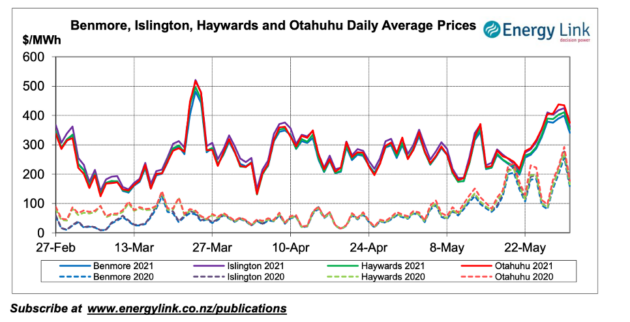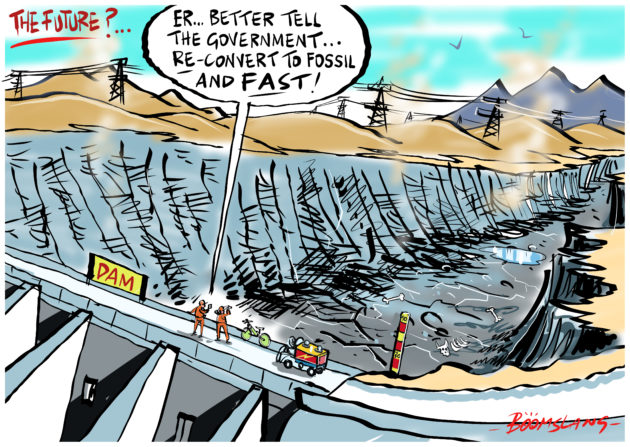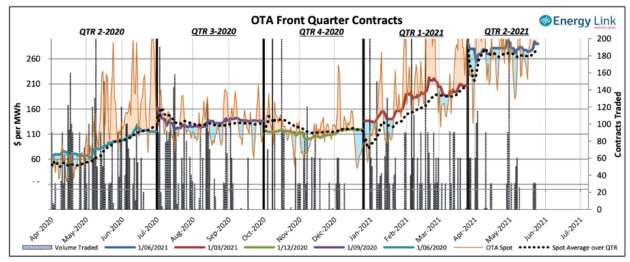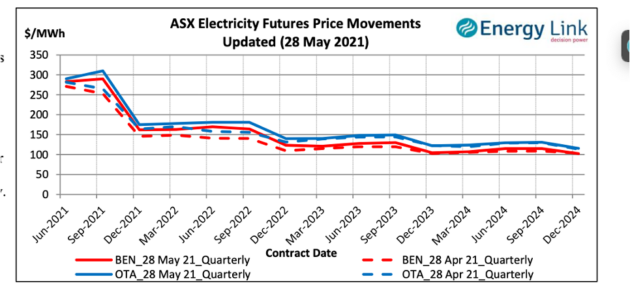Bryan Leyland
Bryan Leyland MSc, DistFEngNZ, FIMechE, FIEE(rtd) is a Power Systems engineer with 60 years of experience in the industry in New Zealand and overseas. He and his wife are majority owners of a small hydropower station.
Up until May 2020 wholesale prices for electricity on the spot market were around 8¢/kWh. They have increased rapidly since then to about 25¢/kWh. Within a year domestic electricity prices are likely to rise by ~30% to more than 40¢/kWh – an increase of about $1,000 per year for the average household. Charges to commercial and industrial consumers have already doubled.

Electricity prices are skyrocketing because of the flawed electricity market and the fact that that nobody is responsible for ensuring that we have a reliable and economic supply.
The supporters of the market promised us a low cost, adequate and reliable supply even in a dry year. It hasn’t happened.

An efficient market would ensure that every new increment of generation was chosen because it would be the best option for providing a low-cost reliable supply into the future. This does not happen with the present market. We are now committed to building wind farms even though we do not have the backup supply needed to keep the lights on in a week of low wind. Lake Onslow is not an option because it would quickly pump Lake Roxburgh dry when surplus wind power was available.
At the moment our power system is short of water and gas, and Huntly power station is running flat out on coal. If the next three months are unusually dry – and this is what NIWA has predicted – there is a risk of blackouts. But one thing is certain: the current high spot prices will cost consumers millions of dollars over the next few years. A much smaller sum of money invested in making sure we had sufficient energy in reserve for dry years would have held prices at a reasonable level.
With the existing market, new generation investment is very risky and encourages investment in low cost power stations that can be built quickly and will bring a good return in the short term even though more expensive long life stations are a better option for NZ Inc.

In their retiring speeches, two gentailer CEOs said that the way to make a profit in this market is to keep the system on the edge of a shortage. It follows that when a dry year comes along there is a high risk of high prices and, possibly, blackouts. At the same time, many generators make windfall profits.
During shortages the generators jack up the spot price because this is how the market is supposed to influence supply and demand. But once all the stations are generating flat out – as they are now – further price rises no longer increase supply. High prices do not result in a substantial reduction in demand because most consumers don’t see the price rise until months later. Industries that buy on the spot market, and, like dairy companies, have no alternative but to keep on processing, are severely damaged.
According to the Major Electricity Users Group “If the prices continue on the pathway that they are on… there will be a number of major industrial operations in the country that simply won’t be in business anymore… We’re looking at the loss of thousands of jobs…”

In the “bad old days” electricity consumers were given early warning of the risk of shortages and everyone did their bit towards reducing demand. This worked well without any need to increase prices.
In our brave new world, the government has decreed that in the event of a shortage, it will force industries to shut down and shed jobs before consumers are asked to reduce consumption. So your lights stay on, but you lose your job and struggle to pay the electricity bill.
According to BusinessDesk, the high prices could extend into 2022 because of a shortage of gas. The Gas Industry Company has also warned of the risk of major shortages beyond 2026. The inevitable increase in gas prices will further increase electricity prices.
If our power system were properly coordinated it would ensure that sufficient energy was held in reserve in the lakes, in gas storage and in the coal stockpile to get us through a dry winter. Right now we are seriously short of reserve energy and the country desperately needs unusually heavy rain in the hydro catchments. If it doesn’t rain the high prices will continue and will hurt poor people the most.
The drive to shut down fossil fuel generation and build more wind farms will generate extreme price fluctuations. When the wind is blowing, spot prices will crash and when it stops blowing, they will skyrocket and rotating blackouts may be needed. Consumer prices will continue to increase.
The government is putting pressure on industry to replace coal-fired boilers with electric boilers. Given the shortage situation, the electricity needed by the electric boilers can only come from burning more coal at Huntly. For every tonne of coal saved by industry shutting down a coal fired boiler, Huntly will need to burn 2½ tonnes of coal to provide the necessary electricity. Madness! Banning gas connections and subsidising electric cars will further increase CO2 emissions from Huntly.
Common sense says that we should not switch transport and heating to electric power until we have substantially emissions free power generation. This could take years.
The government should delay promoting electric cars, gas to electricity conversions and electric boilers until the power system is more than 95% emissions-free. It should also reform the electricity market, explore for more gas and, in particular, shale gas in the South Island. It should also consider adopting nuclear power.
Further information:
Please share so others can discover The BFD.

